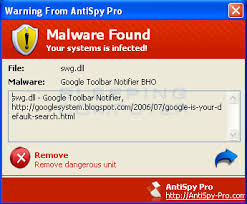
Dealing with Dealing with Malware
“Malware” is the term used for any software that is remotely, and most times unknowingly, installed on a computer for the purpose of gathering information and sharing it with third parties. It is a big problem for computers running Microsoft Windows.
Types of Malware
- Adware: displays ads when you are surfing the web (pop-up windows or banners)
- Spyware: software that secretly gathers information and transmits it to interested parties. This information could be web sites you visit, browser and system information, or your computer IP address.
- Browser Hijacking Software: advertising software that modifies your browser settings (e.g. default home page, search bars, toolbars), creates desktop shortcuts, and displays intermittent advertising pop-ups. Once a browser is hijacked, the software may also redirect links to other sites that advertise, or sites that collect Web usage information.
How Malware Is Installed
There are several ways that Malware can be unknowingly installed on your computer:
- Software bundled with "other software".
- Download managers and file sharing applications often come with malware.
- You should be wary of downloading any free software.
- Software that offers to speed up the internet will contain adware.
- Malicious ActiveX Control
- At some web pages you will be prompted to run ActiveX control (Microsoft technology that links desktop technology to the Internet).
- You should only click yes if it is a trusted web page. With untrusted web pages you run the risk of getting infected with malware when you run it.
- It is important to make sure your IE security settings are not set lower than normal so it won't run automatically.
- Some web sites will tell you that software is needed to view the site
- If you click 'yes' to install the software you have malware.
- Concealed HTML attachments
- HTML attachments leave malware on your computer.
- You should configure email tools, like Outlook Express, to render html mail as text.
Some malware provides no uninstall option, and installs itself in unexpected and hidden places (e.g. modifies the operating system, thus making it more difficult to remove).
Malware can be the vehicle used to a trojan (a program that appears safe, but contains a virus).
Some malware is so severe, it means you have to re-image your computer (re-install the operating system), and there is a risk of losing personal data.
How do You Know if You Have Malware?
There are many symptoms, some of which include:
- poor system performance
- computer takes longer to startup
- browser closes unexpectedly or stops responding
- when performing a search, results are on a different site
- clicking on a link does nothing, or goes to an unrelated page
- browser home page changes to a different site and you can't change it back
- pop-up advertising windows appear when the browser is not open or over web pages that don't normally have pop-ups
- additional toolbars are added to the browser
- web pages are automatically added to the list of favorites
- desktop icons are automatically added to the desktop
- when you are viewing a web site, other instances of your browser open to display advertisements
- you cannot start a program
Malware Culprits
If you would like a list of culprits and descriptions, check out
SpywareGuide.com.
Removing Malware
Protecting your computer from malware is different from protecting against viruses. Having an up to date anti-virus program is important but will not guard against malware. To do this you must have a separate program installed on your computer.
There is no one product currently available that is designed or capable of catching all malware.
Be careful about bogus software that claims to clean malware!!! Some programs that claim to get rid of malware actually put more on your computer. You should be very hesitant to what programs you download. We recommend using Spybot and Ad-Aware.
Spybot Search and Destroy
Spybot is free, but donations are welcomed to help with costs. You can
download Spybot.
You should be careful as it has been reported that there are other sites pretending to be Spybot, which are actually sites spreading malware.
You will need to regularly check for updates, immunize and run a scan to ensure the security of your computer.
Ad-Aware
Ad-Aware is free for home computers, but there is a fee for installing on commercial computers. You can
download Ad-Aware.
You will need to regularly check for updates and run a scan to ensure the security of your computer.
Preventative Measures
There are some other steps you can take to reduce the risk of installing malware:
- Make sure you install the latest Symantec (Norton) AntiVirus updates weekly and keep real time protection turned on.
- Keep your computer patched and firewalled.
- Run your antispyware software on a regular basis and keep it updated.
- After you remove spyware reboot and scan again.
- Use more than one antispyware tool (Spybot and Ad-Aware are recommended).
- Make sure your Internet Explorer security settings are set to at least medium. (Tools->Internet Options->Security).
- Block pop-ups in IE (Tools->Internet Options->Privacy)
- Configure your email tool to render html as text.
- Remove yourself from Power User Status.
NOTE: Few malware ,torjaon made changes in system registry so spy boat will not able to remove it , then you can restart your pc in safe mode and run it ...:) its amezing
References
Other reference sites to help keep your computer secure:







No comments:
Post a Comment